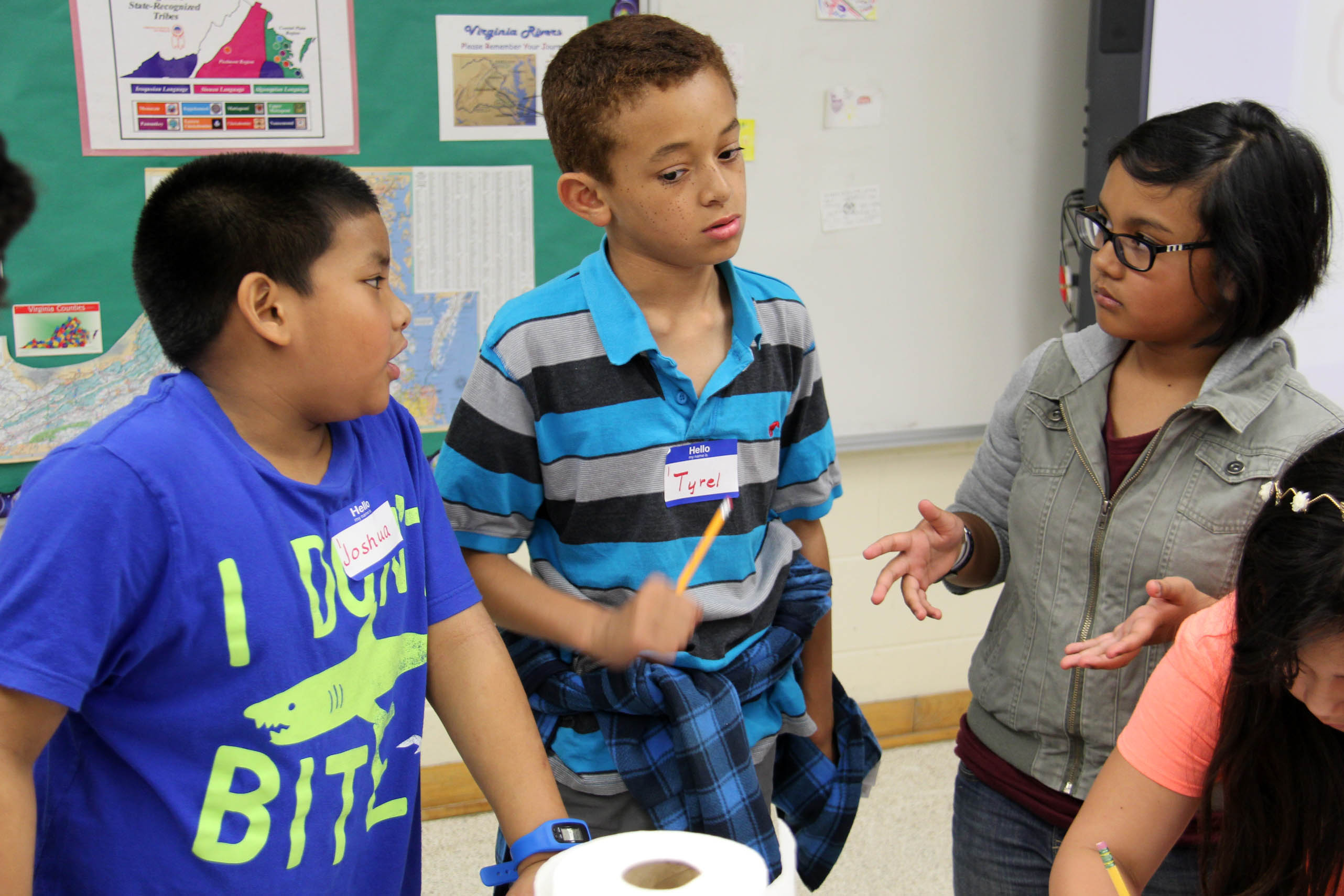Fifth-grader Jace Thrasher asked the small group of kindergarteners to open their eyes and share “in a whisper voice” their guesses of what was in the shoebox.
On the count of three, the Rosemont Forest Elementary School (RFES) students quietly responded together, “Feathers.”
They explained the mystery items were soft to the touch, one of the five senses they are studying in class.
Across the room, kindergartners with fifth-grader Kailee Haske opened their eyes and described the rough, hard edges of a rock. They also detected the smell of an orange half and identified beach sand and ping pong balls by their respective sounds.
“Kindergarteners are smarter than I anticipated,” Haske told RFES assistant principal Ann Shufflebarger.
Haske and her fifth-grade peers had similar revelations throughout the day as they led experiments across all grade levels for the school’s STEM Day.
Kindergarten lessons focused on senses, third-graders investigated soil, second-graders collected data from weighing gummy bears – all under the guidance of their fifth-grade student instructors and all aligned with science curriculum for that grade level.
It’s a practice RFES fifth-grader teacher Brad Ward calls “Teach it Forward,” and the learning target bulletin board in his classroom identifies the goals for the day.
“Their way of proving they know experimental design is that they can teach it to someone else,” explained Ward.
“It gives the younger kids an experience with science experiments, but it’s more for the fifth-graders to show that they really know what they are talking about,” Ward added. “We’ve been doing experiments all year and learning different pieces of the process, and this is the culminating summative assessment.”
Proving she knew what she was talking about was fifth-grader Jasmine Bugarin.
Bugarin worked with fourth-graders who are learning about ecosystems and watershed this grading period. The students simulated oil spills in pans of water and hypothesized which one of three materials – sponges, cotton balls or cornstarch – would have the greatest affect to clean up the water.
Like a good teacher, Bugarin asked questions to have students demonstrate their thinking.
“So out of the three, which do you think absorbed the most water?” she asked.
“The sponge,” responded one of her fourth-grade students.
“Why do you think that?” Bugarin probed.
“The water in that pan is lighter than the other ones, which means it’s a lot more clean,” added the fourth-grader.
“What do you see in the other two [pans]?” continued Bugarin before repeating the scientific inquiry with another group member who thought cornstarch would be the most effective.
Nearby, fifth-grader Dawn Artimisi suggested to her group of students, “Let’s go back to our hypothesis.” They speculated that the sponge would be the best, but their data showed the presence of cotton balls yielded cleaner water.
Artimisi remembers feeling nervous when she was a fourth-grader at STEM Day last year.
No nervous feelings this year.
“I was kind of excited,” Artimisi said of being in the teacher. She worked to reassure her students and guide them through the experiment.
“It was actually really fun,” said Bugarin of her teaching experience as she and her peers cleaned up the room and prepared for the next group.
“And doing the experiment with them will help them know what’s going to happen in fifth grade next year,” she continued.
Did Bugarin, as the instructor, gain new knowledge in the process?
“I learned that the experiment can go through some errors and can end up differently than the others,” she said. “So you adjust. You can learn more of what happens to new things that you haven’t done before.”
That’s another outcome of Teach it Forward that Ward values.
“So many of them are used to ‘the teacher tells me something and I remember it and answer it on a test.’ They don’t have that much exposure to taking responsibility, not for what they know, but how they use what they know. They find a confidence in their abilities that they don’t have to rely on a teacher to tell them everything. There is a lot of problem-solving that comes through it,” Ward said.
“Until they experience it, they don’t know how to fix it if it doesn’t work,” continued Ward. “You saw there were lots of them that didn’t work out the way we planned it, so some of them are changing the experiment on the fly, which is teaching. That’s what we do every day.”
An appreciation for teaching also was noted by principal Greg Furlich, who circulated throughout classrooms to observe grade-level investigations and the student teachers.
“When I asked the fifth graders what they learned today, almost all of them commented on how difficult it was to teach. They definitely came away with a new respect for their own teachers,” Furlich said.
“I overheard one fifth-grader tell her teacher, ‘I don’t know how you do this for seven hours a day!’” said Furlich. “Other students like Kailee Haske seemed to be born to teach. She looked like she was ready for her own class of 20 kindergartners.”
Tell your friends!














